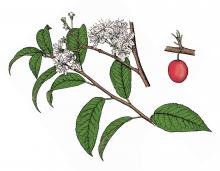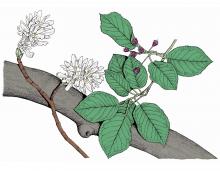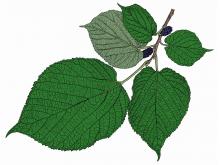Trees, Shrubs and Woody Vines
Media

Species Types
Scientific Name
Juglans nigra
Description
Easily Missouri’s most valuable tree, the black walnut provides the finest wood in the world, as well as delicious nuts. Both are in high demand and thus form an important part of Missouri’s economy.
Media

Species Types
Scientific Name
Rhus glabra
Description
Colonies of smooth sumac are most noticeable in early autumn, because the leaves turn brilliant red! You can make drinks and jellies from the clusters of fuzzy red berries.
Media

Species Types
Scientific Name
Carya texana
Description
Black hickory's nut, like that of the pignut hickory, is awfully hard to crack. Because rural Ozarkers noticed their hogs had no trouble extracting the sweet kernels, both species came to be called "pignut hickories."
Media

Species Types
Scientific Name
Carya illinoinensis
Description
The pecan, a type of hickory, is one of Missouri’s favorite nut trees. Originally pecan had a fairly limited, southern distribution, but today it is found in and out of cultivation nearly statewide, owing to the popularity of the nuts.
Media

Species Types
Scientific Name
Juglans cinerea
Description
Butternut, or white walnut, is closely related to the more common black walnut. Both have delicious edible nuts, and both are valued for their wood. Butternut, however, is declining due to a usually fatal fungal disease.
Media

Species Types
Scientific Name
Rhus aromatica
Description
Unlike its cousin poison ivy, fragrant sumac is a peasant, nontoxic plant. Note the middle leaflet of its "leaves of three": On fragrant sumac, there is no (or at most a very short) leaf stalk on that middle leaflet. Also, fragrant sumac has hairy, reddish fruits (not waxy whitish ones).
Media

Species Types
Scientific Name
Prunus americana
Description
A shrub or small tree with clusters of white flowers in the spring, and small, edible, red or yellow fruits in mid- to late summer, wild plum is a popular tree for landscaping.
Media

Species Types
Scientific Name
Amelanchier arborea
Description
Downy serviceberry is a tall shrub or small tree found throughout Missouri in open or rocky woods. It is one of the earliest spring trees to bloom, producing showy white flowers. The springtime flowers, the purplish, often sweet berries, and the brilliant fall color make serviceberry an attractive landscaping tree.
Media

Species Types
Scientific Name
Viburnum prunifolium
Description
Black haw is a small understory tree with beautiful fall color — deep lavender or maroon-purple, finally becoming deep rose-red. Its clusters of blue-black berries, borne on red stalks, happen to be quite tasty. No wonder it has been cultivated as an ornamental since 1727!
Media

Species Types
Scientific Name
Morus rubra
Description
Red mulberry is native to Missouri and North America. You can distinguish it from the introduced white mulberry tree, which is a noxious weed, by its leaves and fruits.
See Also
About Trees, Shrubs and Woody Vines in Missouri
There are no sharp dividing lines between trees, shrubs, and woody vines, or even between woody and nonwoody plants. “Wood” is a type of tissue made of cellulose and lignin that many plants develop as they mature — whether they are “woody” or not. Trees are woody plants over 13 feet tall with a single trunk. Shrubs are less than 13 feet tall, with multiple stems. Vines require support or else sprawl over the ground.





















